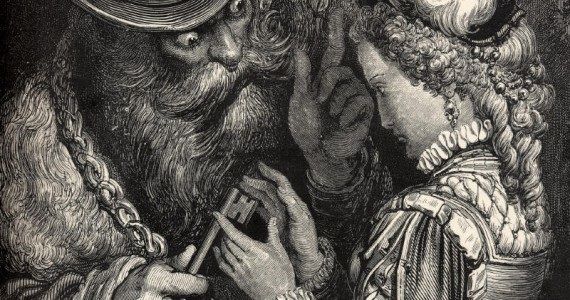Gentle Reader,
It's no secret that many of the most famous fairy tales, in their oldest written versions, are quite violent and dark, and not at all suitable for children--at least, not according to contemporary standards. The disturbing content of these stories can be excused, to some degree at least, by the stories' obvious purpose as cautionary tales. Others, however, are more difficult to excuse and, I would argue, much more difficult to explain.
Bluebeard is my personal favorite of the classic fairy tales, and it definitely fits the criteria for being both macabre and inscrutable. The appeal of this story is precisely its darkness and the vagueness of the overarching lesson or point, which is hinted at in various ways in various retellings, but always seems bizarrely slanted and beyond easy reach. I also like the fact that, while Bluebeard is unquestionably part of
the classic fairy tale canon, it is also one of the more obscure stories
(at least here in the United States).
I've seen it speculated that Bluebeard is based on some ancient story only half-remembered, or that it is an exaggeration of real events. I find this theory compelling, simply because of the incongruent and unusual structure of the story. For example: the new husband's blue-tinged beard is a source of alarm for his young bride, yet while we might infer that it is due to some curse or enchantment, the origin and meaning of the color are never revealed. This is contrary to many other fairy tales, where the characters are either basic archetypes lacking distinguishing features, or where their distinguishing features are key story points whose purposes are made clear. Also, while it is apparent that Bluebeard murders his wives as retribution for their inevitable betrayal of him, we are given no clue as to why Bluebeard killed his first wife. The others were murdered for entering the forbidden room and finding the corpses of their predecessors, but this obviously could not have applied to the first. Did the beard's blue color stem from this original, mysterious murder? We simply don't know.
As with most fairy tales, there are any number of ways for the story to be understood, and certainly, there is no shortage of scholarship on the subject. Personally, I think that the most interesting angle is Bluebeard's seeming compulsion to place himself in a situation, over and over again, where his wife is driven to betray him. He seems to fear the betrayal, but also expect it, seemingly not realizing the degree to which it is all a self-fulfilling prophecy, and therefore needless. Or perhaps his strange blue beard really is the mark of a curse, where forces beyond Bluebeard's control force both himself and his wives into the same doomed scenario despite the best-laid plans and purest intentions.
I rather like this interpretation. Bluebeard is undeniably mad, and a figure of terror, but I think that the story works on so many more levels if he is victim as well as monster. In the end, he dies by the hand of his final wife's valiant rescuers without offering any explanation for what he does, and this is appropriate. Real monsters rarely provide an accounting that their victims could understand, and those of us who survive are often left to invent our own explanations. This is, after all, the origin of fairy tales, legends, and all stories, really--the search for meaning, imperfect and elusive, in both the miracles and horrors of the world.
Bluebeard on Wikipedia
Grimm's Fairy Tale Classics, unaired Bluebeard episode
Ever Yours,
Fauntleroy

No comments:
Post a Comment
Note: Only a member of this blog may post a comment.